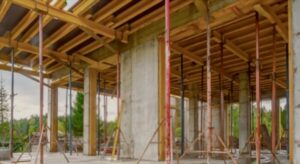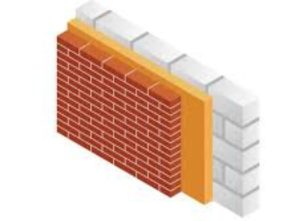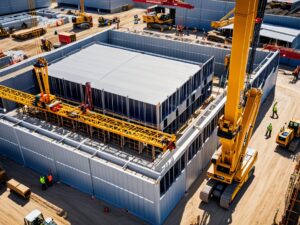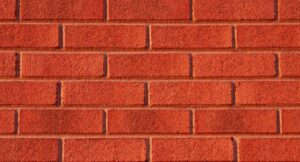Curtain walls are a type of building construction that is used to separate the interior space from the exterior space. They can be made from different materials, such as steel, aluminum and glass.
Curtain walls are usually considered more attractive than other types of walls because they allow for more natural light and provide better views.
What is Curtain Wall System?
A curtain wall system also called curtain walls, glazed facades, or glass facades is one of the many different types of exterior cladding systems you can use to build your building.
These walls don’t bear heavy structural load. All curtain wall systems offer clear, transparent glass windows and doors that let in lots of natural light and act as a barrier against the elements, such as rain and wind; however, they can also be used as an aesthetic element on buildings.
While there are many ways to create these glass walls, we’ll be going over the basics of these systems in this topic.
The History of Curtain Walls
Curtain walls are a type of construction that is used to enclose the outside of a building. This technique was invented in the 1800s by engineer Robert Thom. The name “curtain wall” comes from the idea of constructing a frame that looks more like pieces of fabric than solid blocks.
Types of Curtain Walls
Curtain walls are an outer layer of a building that is used to enclose the building. A curtain wall can be composed of glass, metal paneling, or another material that allows light to pass through it.
The most common curtain wall is a glass curtain wall. This type of curtain wall is used on many office towers and high-rise buildings for its transparency, glare control, and insulation properties.
They are usually installed on the outside of a building, but can also be used indoors. There are three main types of glass curtain walls unitized, stick, and structural glazed.

Unitized curtain walls
A unitized curtain wall is an architectural system that combines the benefits of a curtain wall with the simplicity of a modular building system.
Unitized curtain walls typically consist of two or more panels that are stacked and interconnected to form a structural whole. The panels are often formed by extrusion and are typically reinforced by embedded steel rigid frames for stability. The panels can be made from any material such as glass, aluminum, or steel.
In comparison with traditional curtain walls, unitized curtain walls provide simpler construction, greater insulation, and reduced maintenance cost. One major benefit of unitized curtains is that they can be “assembled” from prefabricated modules which makes erection quick and easy without having to fabricate on-site.
Stick curtain walls
Fixed curtain walls, or stick curtain walls, are the most common type of curtain wall. They are efficient, lightweight and strong.
A sticking wall is a type of curtain wall where the vertical members (vertical columns) and horizontal members (horizontal beams) meet in a point at the top and bottom, forming a capital “T.” When installing this kind of curtain wall system you need to make sure that you don’t cut corners – it doesn’t work as well if you don’t fit in all pieces correctly.
Stick curtain walls are popular because they do not take up much space and are less expensive. They also provide better insulation and sound control than regular walls, which makes them popular with living spaces in urban areas that may be surrounded by other buildings with lots of noise and activity.
Structural glazed curtain walls
Structural glazed curtain walls are a type of curtain wall that provide structure and strength to the curtain wall system.
Structural glazed curtain walls are the perfect choice for taller buildings because they provide strength to the system and make it possible for them to use a thinner profile. Also, they offer fire protection, which is an important feature in taller buildings.
The different components in a curtain wall
Generally, curtain walls are composed of the following parts:
– Curtain Wall Elements: These include the building façade and the outermost layer of the curtain wall.
– Core columns: Core columns are located at the exterior corners or on intermediate supports for curtain walls that extend beyond one story.
– Supports: Supports are intermediate structural members in a curtain wall. They can be either interior or exterior supporting elements.
– Transoms and glass panels: Transoms and glass panels provide access to the interior space from a higher floor by breaking up the façade into glass panels, which allows light to enter through them.
The thickness of the curtain wall glass is typically 3/4 inch to 1 inch. You will need to measure your window and cut the metal frame accordingly.
Different Uses For Curtain Walls
To provide energy efficiency:
Curtain walls are a type of external cladding that opens like a curtain. They are often used to provide energy efficiency by controlling the amount of heat transfer through the building envelope.
To protect against sound:
Sound waves can cause a lot of problems in buildings and even potentially lead to hearing loss; this is why curtain walls are often used to reduce the transmission of sound through the facades.
To improve environmental performance:
A lot of curtain walls have been designed with sustainability in mind, for example, they have been made from sustainable materials such as timber or recycled plastic bottles and they feature low-emission glass or natural light harvesting techniques like wind turbines or solar panels on the outside surface of them.
To Improve Decoration of Building:
When these structures are used for decoration, they can be installed on buildings in order to add beauty. This is a popular option that is often shown in high-end neighborhoods or sprawling parks.
To Improve Protection of Building:
In terms of protection, these structures can offer some additional benefits. They can help protect the building from natural disasters such as hurricanes and tornadoes and also from other types of damage that might occur over time.
Disadvantages of using a curtain wall
- Installation of curtain walls is generally more expensive than installation of other types of wall systems.
- In order to achieve the required fire rating, the thickness of the curtain wall glass must be increased, which can result in a loss of transparency.
- Achieving an airtight seal around the perimeter of the curtain wall can be difficult, resulting in air and water infiltration.
- Curtain walls are prone to condensation, causing frost on the inside surface of the glass during cold weather months.
- High-quality materials used for construction require higher maintenance costs associated with cleaning, exterior coating protection and regular maintenance such as window washing.
Parts Of Curtain Wall
A curtain wall system is made up of several parts, including glass panels, aluminum framing, and mullions. The glass panels are the largest part of the system and can be either clear or tinted.
The aluminum framing provides support for the glass panels and helps to keep them in place. The mullions are the vertical bars that connect the glass panels to each other and help to support the weight of the system.
The thickness of curtain wall glass can vary depending on the needs of the project. However, it typically ranges from 3/8 to 1/2. When installing curtain walls, there are four main steps:
– Installation starts with assembling the metal frames. They’re secured together with one end fixed onto an external wall and the other end attached to a concrete base or floor slab.
– Next, the metal frames are bolted together at their intersections.
– Mullions (vertical metal rails) between the window panes must be installed before installation of the glazing units begins. To install a single glazing unit, attach brackets to both ends of the horizontal part of the rail, making sure they line up with brackets already affixed to adjacent rail sections.
– Installers then lift the panel into position and secure it by placing mounting screws through openings in its edges. Glaziers then fit spacer beads between two adjacent windows using plastic wedges so as not to scratch or damage adjacent glass panels. Final touch-ups such as trimming off excess caulking are also done after the installer has ensured that everything fits properly without any interference from outside objects such as trees, poles or chimneys.
Also Read : Shear Wall Types and Design Techniques for Shear Wall
How To Install Curtain Walls
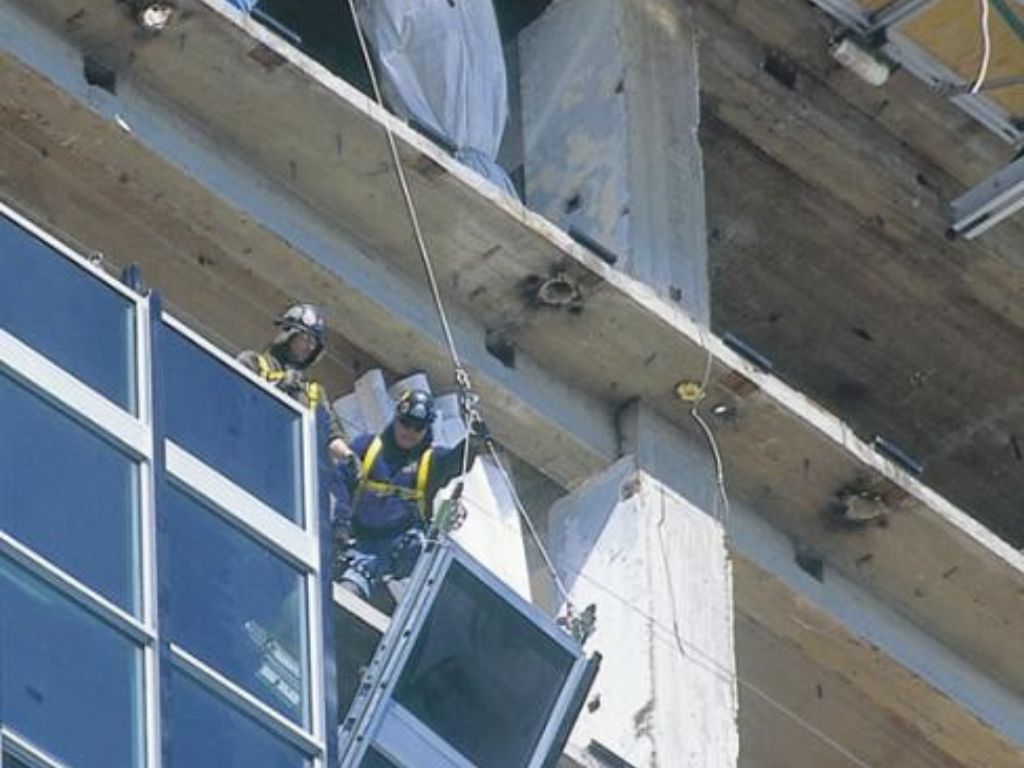
Steps involved in installation of curtain system.
1. Hang the top track using metal hangers screwed into the framing.
2. Affix the jamb brackets to the rough opening framing, level with each other and plumb.
3. Suspend the bottom track from the jamb brackets using metal hangers.
4. Measure and cut the mullion cap to fit snugly over the top of each mullion, then prime and paint it to match the surrounding trim.
5. Cut each curtain wall panel to size, then prime and paint them as well.
6. Set each panel in place between the mullions, then secure them using screws driven through the flanges at the top and
bottom of each panel. It is also recommended to get work done
by experience laboure.
7. The seams where the panels meet should be sealed for long-term weather protection with silicone caulk or clear silicone adhesive sealant.
8. Install a barrier behind the curtain walls on both sides if you have open space behind your glass.
9. To install exterior hardware like an entrance door, window or sliding glass door, measure how far you want it recessed into the outer frame and use that measurement when installing drywall along the edges of your exterior frame.
10. Anchor drywall in place using deck screws so that they are below the surface of your exterior frame and do not protrude through to show on your finished wall.
11. You can get creative with these details by adding things like solid wood frames around windows and doors, accent molding around corners, or different finishes such as brick facing.
12. Installing composite material fiberglass insulation boards between studs will help keep your new home warmer in winter and cooler in summer.
13. It’s also important to note that most modern homes include some type of sprinkler system which may need adjustment after installation of materials such as drywall which change the way water flows throughout the house during fire incidents.
14. Another factor to consider is making sure enough clearance exists around doors so they can swing fully open without interference from adjacent objects – this will vary depending on what type of door you’re installing but generally a minimum distance of 36 should provide adequate clearance.
15. Measure and cut the mullion cap to fit snugly over the top of each mullion, then prime and paint it to match the surrounding trim.
16. Cut each curtain wall panel to size, then prime and paint them as well. It is recommended to paint it with enamel coating.
17. Set each panel in place between the mullions, then secure them using screws driven through the flanges at the top and bottom of each panel.
18. The seams where the panels meet should be sealed for
long-term weather protection with silicone caulk or clear silicone adhesive sealant. Adhesive may lose its strength it is recommended to check it strength during its life span.
How to Choose Curtain Wall System?
When you are looking to purchase a curtain wall, there are a few things that you need to consider. You should start by understanding the function of the curtain wall. You will want to know if your curtain wall is going to be used in an exterior or interior application.
The next thing that you need to think about is what type of material you want your curtain wall made out of. There are many different materials available on the market today, so it can be difficult to decide which one is best for your project.
Some people prefer aluminum curtains because they resist corrosion and they have a good thermal insulation value.
Steel curtains can also provide good thermal insulation, but they do not resist corrosion as well as aluminum curtains do.
If you are looking for something with a more decorative look, then vinyl curtains would be the best option for you.
Also Read: Basic Parts of Building Structure and their uses
Conclusion- Why Choose a Curtain Wall?
A curtain wall is a type of building cladding that is often used in high-rise buildings. It is a thin, vertical surface that extends from the edge of the building to the roof. The curtain wall’s primary purpose is to provide protection from wind and rain while also providing natural lighting and ventilation.
The benefits of installing curtain walls are many, such as:
- Curtain walls are lightweight, which makes them easier to install than other types of cladding materials like stone or brick.
- Curtain walls are relatively inexpensive, which means they can be installed on any budget as well as any size building.
- Curtain walls provide better soundproofing than other cladding materials because they do not have gaps between the panels.


